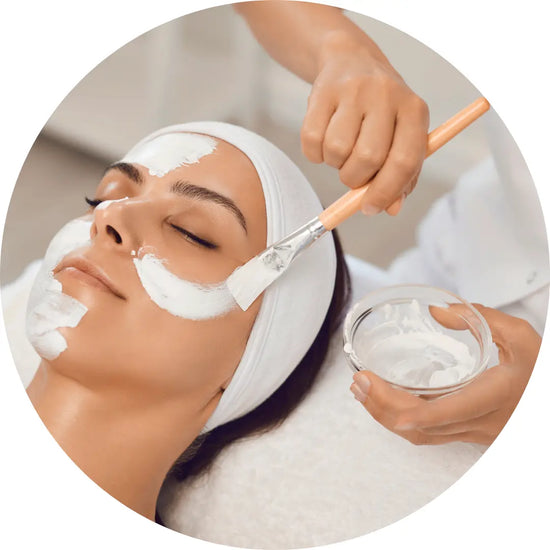Are Clay Masks Good For Your Skin?
Yes, our clay masks are very good for your skin, especially if you have certain skin types or concerns. Clay masks are known for their ability to detoxify the skin, absorb excess oil, and improve the overall complexion. Here are some key benefits of using our clay masks:
Absorbs Excess Oil
Oil Control: Clay masks are particularly beneficial for those with oily or combination skin. They help to absorb excess oil (sebum) from the skin, reducing shine and preventing clogged pores, which can lead to acne.
Mattifies the Skin: After using our clay masks, your skin often feels more matte and less greasy, making it a great option if you struggle with oily skin throughout the day.
Deep Cleanses Pores
Draws Out Impurities: Clay masks work by drawing out impurities, dirt, and toxins from deep within the pores. This deep-cleansing action helps to keep your pores clear and can reduce the occurrence of blackheads and whiteheads.
Prevents Breakouts: By keeping the pores clean and clear,our clay masks can help prevent acne breakouts and reduce existing blemishes.
Exfoliates and Smooths Skin
Gentle Exfoliation: Some clay masks provide a mild exfoliating effect, helping to slough off dead skin cells and reveal smoother, more refined skin. This can improve the texture and tone of your skin over time.
Improves Skin Texture: Regular use of our clay masks can help improve the overall texture of your skin, making it feel softer and more even.
Detoxifies the Skin
Removes Toxins: Our clay masks are effective at pulling out toxins and pollutants from the skin, which can be particularly beneficial for those living in urban areas or exposed to environmental stressors.
Promotes a Clearer Complexion: By detoxifying the skin, our clay face masks can help improve the overall clarity and brightness of your complexion.
Reduces Inflammation
Calming Effect: Some clay masks, especially those formulated with soothing ingredients, can help reduce redness and calm irritated skin.
Helps with Acne: The anti-inflammatory properties of clay masks can be particularly helpful in calming active acne and reducing the redness and swelling associated with it.
Tightens and Firms the Skin
Temporary Tightening Effect: As the clay dries, it tightens on the skin, which can provide a temporary firming effect. This can make your skin feel more lifted and toned after use.
Refines Pores: While clay masks don’t actually shrink pores, they can make pores appear smaller by removing the dirt and oil that can stretch them out.
Improves Blood Circulation
Boosts Circulation: Applying our clay mask and allowing it to dry can stimulate blood circulation in the skin, which can lead to a healthier, more radiant complexion.
Revitalises Dull Skin: The increased blood flow can help to revitalise dull, tired-looking skin, giving it a natural glow.
Versatile for Different Skin Types
Customisable: There are different types of clay (such as bentonite, kaolin, and French green clay), each with specific properties suited to different skin types. For example, kaolin clay is gentler and more suitable for sensitive skin, while bentonite clay is more powerful and better for oily or acne-prone skin.
Blends with Other Ingredients: Our clay masks can be combined with other beneficial ingredients like charcoal, essential oils, or botanical extracts to target specific skin concerns.
When to Use Clay Masks:
1-2 Times a Week: For most people, using our clay mask 1-2 times a week is sufficient to reap the benefits without over-drying the skin.
Spot Treatment: You can also use a clay mask as a spot treatment on problem areas like the T-zone (forehead, nose, chin) or on individual blemishes.
Can Clay Masks Cause Acne?
Our Clay masks are generally beneficial for acne-prone skin because they help absorb excess oil, deep-clean pores, and remove impurities. However, in some cases, clay masks can contribute to or exacerbate acne under certain conditions. Here’s why and how this can happen:
Initial Breakouts (Purging)
Purging: When you start using a clay mask, you might experience an initial breakout or "purging." This happens because the clay draws out impurities, such as dirt, oil, and toxins, from deep within the pores. As these impurities are brought to the surface, they can cause temporary breakouts.
Duration: Purging is usually short-lived and should subside after a few uses. If the breakouts persist beyond a few weeks, it might not be purging, but rather a reaction to the product.
Overuse of Clay Masks
Excessive Drying: Using clay masks too frequently can strip the skin of its natural oils, leading to excessive dryness. In response, your skin might produce more oil to compensate for the dryness, potentially leading to clogged pores and acne.
Irritation: Overuse can also irritate the skin, leading to redness, inflammation, and breakouts. It’s important to use clay masks in moderation—typically no more than 1-2 times a week.
Incorrect Type of Clay Mask
Too Harsh for Sensitive Skin: Some types of clay, such as bentonite or French green clay, are very powerful and may be too harsh for sensitive or dry skin, causing irritation and potentially leading to breakouts.
Incompatible Ingredients: Some clay masks may contain additional ingredients that could irritate your skin or cause allergic reactions, leading to acne. It’s important to choose a clay mask that is suitable for your skin type and free from potential irritants.
Incomplete Removal
Residual Product: If the clay mask is not thoroughly removed from the skin, it can leave behind residue that clogs pores and contributes to acne. Make sure to rinse off the mask completely with lukewarm water and follow up with a gentle cleanser if necessary.
Using on Already Irritated Skin
Exacerbating Existing Conditions: If your skin is already irritated or has active, inflamed acne, using a clay mask might worsen the irritation, leading to further breakouts. In such cases, it’s better to allow your skin to heal before using a clay mask.
Allergic Reactions
Allergy-Induced Breakouts: Some people might be allergic to certain clays or ingredients in the mask. An allergic reaction can manifest as breakouts, redness, itching, or swelling. If you suspect an allergic reaction, discontinue use immediately and consult a dermatologist.
Tips to Prevent Acne from Clay Masks:
Use in Moderation: Limit clay mask use to 1-2 times per week to avoid over-drying and irritation.
Choose the Right Mask: Select a clay mask suited for your skin type. For example, if you have sensitive skin, opt for a gentler clay like kaolin.
Patch Test: Always perform a patch test before using a new clay mask to check for any adverse reactions.
Proper Application and Removal: Apply the mask evenly and avoid leaving it on for too long. Rinse thoroughly to ensure no residue is left behind.
Follow Up with Moisturiser: After using a clay mask, follow up with a hydrating moisturiser to replenish the skin’s moisture barrier.
Can Clay Masks Remove Blackheads?
Clay masks can be effective at helping to remove blackheads and prevent new ones from forming. While they may not always remove blackheads entirely on their own, they can significantly reduce their appearance and prevent future blackheads by deep-cleaning the pores and controlling oil. Here’s how clay masks work to address blackheads:
Absorbs Excess Oil
Oil Control: One of the primary causes of blackheads is excess oil (sebum) that gets trapped in the pores. Our clay masks absorb this excess oil from the skin’s surface and within the pores, helping to reduce the likelihood of blackheads forming.
Keeps Pores Clear: By reducing the amount of oil in your pores, clay masks help keep them clear and less prone to clogging, which is essential for preventing blackheads.
Draws Out Impurities
Detoxification: Clay masks have a natural ability to draw out impurities, dirt, and dead skin cells from deep within the pores. This helps to remove the buildup that can contribute to the formation of blackheads.
Unclogging Pores: When the clay dries on your skin, it pulls out impurities, including the oil and dead skin cells that can clog pores and lead to blackheads. This deep-cleaning effect can help to loosen and remove blackheads over time.
Exfoliates the Skin
Mild Exfoliation: Some clay masks provide gentle exfoliation, which helps to remove dead skin cells on the surface of the skin. Exfoliating the skin prevents these cells from clogging pores, reducing the chances of blackheads forming.
Improves Skin Texture: The exfoliating action of clay masks can also smooth the skin’s texture, making pores appear smaller and less noticeable.
Minimizes the Appearance of Pores
Pore Refinement: While clay masks don’t actually shrink pores, they can make pores appear smaller by keeping them clean and free of debris. When pores are clean and not stretched by excess oil or buildup, they look less prominent, reducing the appearance of blackheads.
Temporary Tightening Effect: As the clay mask dries, it tightens on the skin, which can temporarily minimize the appearance of pores and make blackheads less noticeable.
5. Prevents Future Blackheads
Regular Use: Consistent use of clay masks can help maintain clear pores by regularly removing oil, dirt, and dead skin cells. This preventive action helps reduce the recurrence of blackheads.
Limitations of Clay Masks for Blackheads:
Not a One-Time Solution: While clay masks can help loosen and remove some blackheads, they may not completely eliminate all blackheads, especially those that are deeply embedded. For more stubborn blackheads,p professional extractions may be necessary.
Complementary to Other Treatments: Clay masks work best when used as part of a broader skincare routine that includes regular cleansing, exfoliation, and treatments specifically targeting blackheads.
How to Use Clay Masks for Blackheads:
Cleanse Your Face: Start with clean skin to ensure that the mask can penetrate effectively.
Apply the Mask: Apply an even layer of the clay mask to areas prone to blackheads, such as the nose, chin, and forehead (the T-zone). You can apply it all over your face if desired.
Let It Dry: Leave the mask on for the recommended time, usually 10-15 minutes, until it dries completely. Avoid leaving it on too long, as this can overly dry the skin.
Rinse Thoroughly: Rinse the mask off with lukewarm water, making sure to remove all traces of the mask.
Follow Up with Skincare: After removing the mask, follow up with a toner, serum, and moisturiser to replenish and hydrate the skin.
Why Do Clay Masks Tighten Skin?
Clay masks tighten the skin as they dry because of the physical properties of the clay and the way it interacts with your skin during the masking process. Here’s a breakdown of why clay masks cause this tightening effect:
Water Evaporation
Drying Process: When you apply a clay mask, it starts out wet and pliable. As the mask dries, the water in the mask evaporates, causing the clay particles to contract and harden. This process creates a tightening sensation on the skin.
Skin Contraction: As the clay contracts, it pulls on the surface of your skin, leading to a feeling of tightness. This is a temporary effect and is one of the reasons why your skin feels firmer while the mask is on.
Oil and Impurity Absorption
Absorbing Sebum and Impurities: Clay masks are designed to absorb excess oil (sebum) and impurities from the skin. As the mask absorbs these substances from your pores, it helps to remove buildup, which can create a temporary tightening effect by cleaning out and shrinking the appearance of your pores.
Pore Tightening: When the mask removes excess oil and impurities, it can make your pores appear smaller. This pore-tightening effect contributes to the overall sensation of tighter, firmer skin.
Improved Circulation
Increased Blood Flow: Applying a clay mask can stimulate blood circulation to the surface of the skin. As blood flow increases, it can cause a slight swelling in the skin, which contributes to the feeling of tightness. This increased circulation also gives the skin a temporary glow, enhancing the appearance of firmness.
Temporary Skin Firming
Temporary Lift: The tightening effect of a clay mask can give your skin a temporary lift and firmness. While this effect is temporary and diminishes once the mask is removed, it can make your skin look more toned and refined immediately after use.
Refreshing and Firming Sensation: Many people enjoy the sensation of tighter skin as it can feel refreshing and rejuvenating, making clay masks a popular choice for a quick skin pick-me-up.
Exfoliation
Removing Dead Skin Cells: Some clay masks have a mild exfoliating effect. As the mask dries and is subsequently removed, it can help lift away dead skin cells, which can make the skin feel smoother and tighter. This gentle exfoliation further enhances the sensation of firm skin.
Is the Tightening Effect Beneficial?
Temporary Effect: The tightening effect of a clay mask is generally temporary. It provides an immediate sensation of firmer skin, which can make your skin look more toned and refined for a short period after use.
No Long-Term Firming: While the tightening effect is satisfying, it doesn’t lead to long-term skin tightening or lifting. The effect is primarily due to the drying and contraction of the mask on the skin’s surface.
Not Harmful: The tightening effect is not harmful, but it's important not to leave the mask on for too long. Over-drying the skin can lead to irritation or excessive dryness, particularly for those with sensitive skin.





















